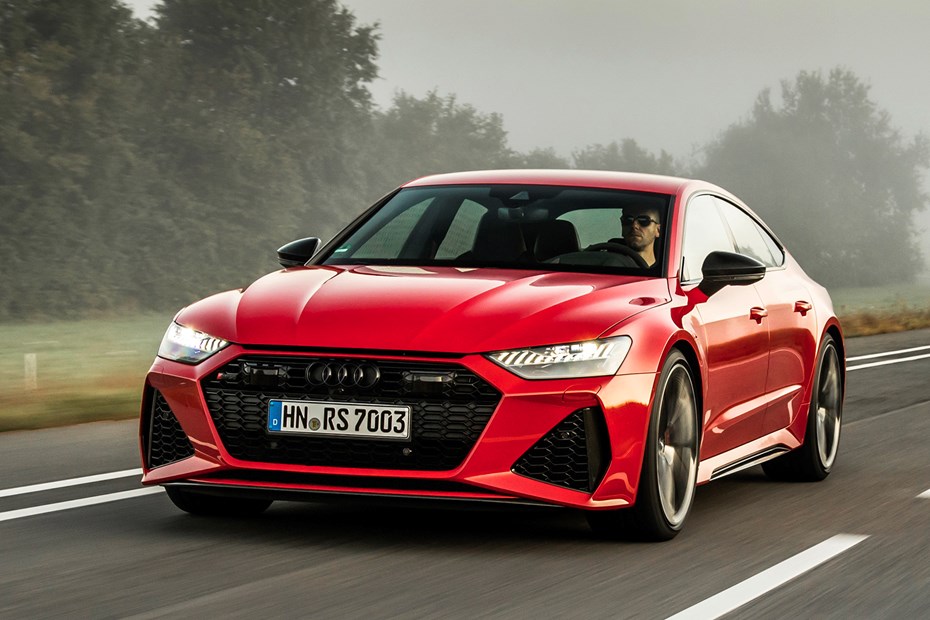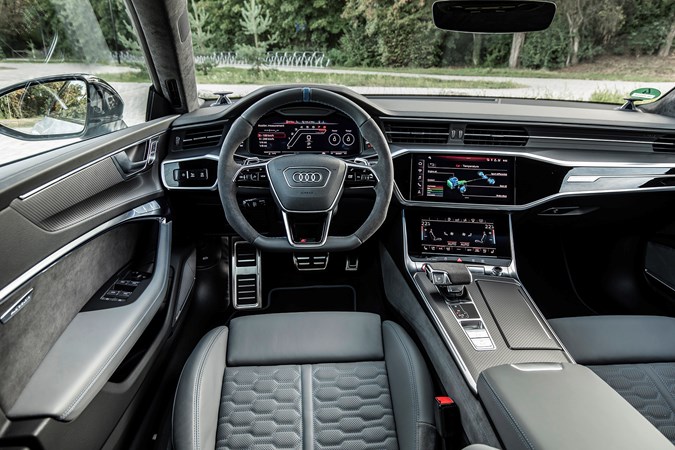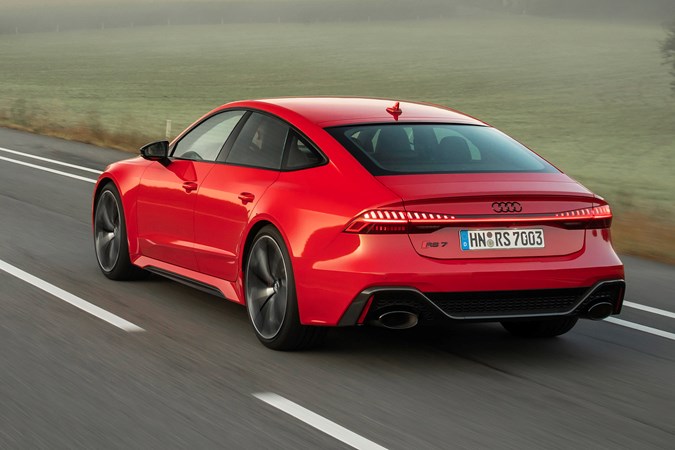Audi A7 RS7 Sportback review

At a glance
| Price new | £116,530 - £133,930 |
|---|---|
| Used prices | £42,080 - £104,994 |
| Road tax cost | £600 |
| Insurance group | 50 |
Get an insurance quote with

|
|
| Fuel economy | 22.1 - 23.2 mpg |
| Miles per pound | 3.2 - 3.4 |
| View full specs for a specific version | |
Available fuel types
Petrol
Pros & cons
- Striking looks, soundtrack and road presence
- Huge performance and strong practicality
- More agile handling than you’d expect
- Is this a car you want on 70mph-limited motorways?
- Big V8 means big fuelling and running costs
- Stiff and jittery ride in Dynamic mode
Overview
The Audi RS 7 Sportback is unlikely to sell in anything other than limited numbers. And it’s equally unlikely that you’ll get any opportunity in the UK to even scratch the surface of its massive range of abilities. But despite that, this range-topping Audi is hugely important for the company, because as one of its RS-badged halo models, it’s going to help sell a lot of everyday Audis by injecting a little bit of filtered-down excitement.
The RS 7 is closely related to the RS 6 Avant. Just like its estate-bodied sister car, this five-door Coupe promises to combine huge reserves of all-round usability and performance, decent amounts of room inside, and a long-legged ability to cross continents in a single hop. The second-generation RS 7 has moved on significantly in tech terms over its predecessor, which in a fast-moving world was something of a necessity.
It’s up against some very impressive – and predictably German – rivals. There’s no way that someone contemplating one of these cars won’t also be considering the Mercedes-AMG GT four-door coupe, the BMW M8 Gran Sport and the Porsche Panamera. That opposition isn’t exactly going to be a pushover, but Audi’s mix of tech, sledgehammer performance and striking looks may well be enough to encourage buyers to stick with their four-ringed warrior.
What’s new in this one?
The formula remains pretty much the same as before, but with the latest Audi styling and tech to differentiate this one. This supercoupe has been engineered to be even more accomplished for everyday use than the last one – and for the first time it can now be specified with a three-person wide rear bench, taking its occupant count to the full five.
Separating this car from the standard model is an overhaul of the exterior design – the bonnet, roof, front doors and the bootlid remain, but everything else is RS specific. That means it’s wider and more aggressive than the standard A7, and is dripping with road presence. You now get a three-dimensional honeycomb grille and the large front air inlets and fins that flank it, all finished in gloss black. It’s a very successful visual transformation, and one of the first where Audi’s widescreen grinning grille doesn’t look too overbearing.
Around the back there’s the distinctive RS exhaust system with its large oval tailpipes, plus a new bumper and rear diffuser pairing, and a bootlid spoiler that pops up at 62mph. The badges are gloss-black, and the standard wheel size is a scarcely-believable 22-inches. Good for UK and its pothole-ridden roads and high kerbs? What do you think…

Under the bonnet – where it’s most special
Just like the RS 6, the RS 7’s crowning glory is what lies under the bonnet. Without doubt, the heart and soul of its vast performance – that mighty V8 – has been modified over the last RS 7 to offer the holy grail of improved performance and economy. Audi has eschewed standard industry practice of downsizing in its performance variants, so no more to a V6 or hybrid, it remains as it was. It will be interesting to see how long it will remain in production for.
The 4.0-litre TFSI that powers the Audi RS 7 Sportback is an astonishing engine, and capable of generating some amazing numbers for its comparatively-modest capacity. Maximum power is 600hp and there’s 800Nm of torque on tap from 2,050 to 4,500rpm. With that much pulling power available, Audi says that it’s as easy and relaxing to drive as any other A7.
Claimed acceleration is impressive, with a 0-62mph time of 3.6 seconds and a maximum speed limited to 174mph with the Dynamic package, and to 189mph with the Dynamic plus package. Not that either is particularly useful in the UK.
Decent economy and emissions… for the performance
A 48-volt mild-hybrid electrical system means a claimed 24mpg and 261-265g/km of CO2 is possible thanks to the ability to shut down half of the engine’s cylinders in periods of low demand (Cylinder on Demand or COD for short), and even coast along under its own momentum. As we found out on the road, this actually has quite a refining effect in day-to-day driving.
An eight-speed Tiptronic automatic transmission is standard, as of course is Quattro permanent four-wheel drive, which can send up to 70% of power to the front wheels and up to 85% to the rears depending on your style of driving. For the UK’s mixed weather conditions, this is added security as well as meaning its vast power is successfully harnessed. On paper, this amount of power and grip, allied with a family-friendly interior makes the RS7 potentially the answer to every well-heeled petrolhead’s wants in a car.
Read on to see if the Audi RS 7 really is that good, including our driving impressions from driving a left-hand drive model in Germany.




